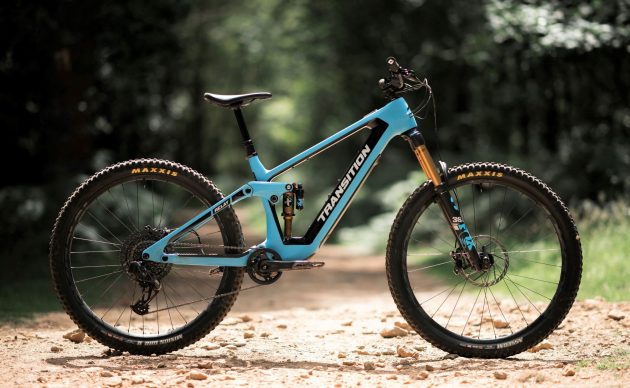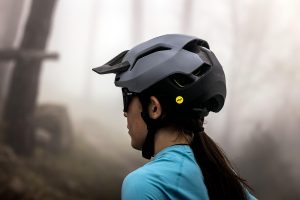Transition's mid-powered e-bike is a rascal, and one of the most fun bikes we've tried this year
Transition Relay Carbon GX AXS first ride review
Transition has made a bike to tempt the e-bike naysayers, a lightweight raver of a bike driven by Fazua’s Ride 60 motor. We rode it until they demanded it back, in a quest to find out how it fares against the best electric bikes you can buy today.
Need to know
- Lightweight, mid-power e-bike with Fazua Ride 60 motor and removable battery
- Built to be ridden with or without 430Wh battery, thanks to near drag-free motor
- 160mm travel front and rear, choice of mullet or 29in wheels, coil or air shocks
- Sleek carbon frame with real bio-bike looks, or available as an alloy frame build
- Builds from £6,999.95 with NX and alloy frame, up to XX AXS carbon at £12,599.95

The Transition Relay has 60Nm of torque and battery, and both are small enough to give out bio-bike vibes
They say there’s nothing really new in mountain biking, just old ideas recycled, like Shimano’s auto shifting, steering dampers and electronic suspension. Here’s another one to add to the list, Fazua’s latest Ride 60 motor has 250W power, puts out 60Nm torque and uses a 430Wh battery. That makes it pretty darned close to the old Shimano E8000 motor and battery launched in 2016, which had the same average power and 10Nm more torque. And, just as it was seven years ago it’s cutting edge stuff, coming on the most exclusive new bikes like this Transition Relay.

Remove the cover and inside is a removable 430Wh battery, rechargeable off the bike only
The difference of course is that today’s mid-powered motors have sacrificed the peak power for low weight and compact size, in an effort to replicate the look and ride feel of a regular bike. Fazua’s Ride 60 motor is claimed to weigh just 1.96kg, while the 430Wh battery is easier to verify because it’s removable on the Relay, and reads 2.27kg on our scales. That 4.23kg system weight is light but on the other hand it’s actually only 1,100g less than the old E8000 motor and bigger 504Wh battery, according to Shimano’s website.
You’ll be relieved to hear Fazua wins in terms of space savings too, the Ride 60 motor is so tiny you’d be forgiven for thinking the Relay is a regular bike, and the fact you can whip the internal battery out and pedal it around is useful, even if just for the ability to charge the battery off the bike.
Powered up, the display uses a traffic light system, and it is integrated into the top tube, with a series of lights to let you know how much juice you have left and which of the three power modes you’re in. The claim is it’s intuitive because the lights instantly remind you of the mode you’re in, but to do that you have to first learn which colour relates to which power mode. I’d argue words and letters are more intuitive as most of us have already learnt them. I also found the LEDs far too bright for riding at the end of a summer’s day, so I imagine they’re blinding on a night ride.

The Ring controller is easy to use and very subtle, while the coloured panel in the top tube displays the remaining battery and current power mode
The bar-mounted Ring Controller remote used to select the power modes is a simple up-down switch that floats on a bushing and uses magnets to select the modes. It’s unobtrusive, works most of the time (it does tend to get sticky when gritty) and is very tactile. It’s also easy to clean.
Compared to the old Ride 50 system, you get more peak power with Ride 60; 350W, and there’s even more in reserve if you need it – hold the remote in its up setting and it’ll give you a 12 second boost at 450W.
In terms of availability, Transition has alloy or carbon frames, and there are six builds, from NX at £6,999.95 up to XX AXS at £12,599.95. The bike I have comes with 29in wheels and suspension provided by Fox’s Performance Elite range. You get 160mm travel front and rear, or there are two Pacific Northwest (PNW) builds with 170mm travel, a mullet setup and coil shocks. There’s also a flip chip on the lower shock mount so you can mullet the bike yourself and still maintain the same ride height by putting it into High mode.

The Relay is playful and responsive, it’ll get air whenever it can, so your only job is trying to hold it back
How it rides
Transition says the Relay is “two bikes in one” so we’ll start there. It does work with the battery out. It’s certainly easy to remove, probably the easiest of any system I’ve tried – pop the plastic cover off, pull on a rubbery coated lever and out it slides. There’s no noticeable drag with the motor off, while the ride feel is pretty much the same, albeit slightly less planted with some of the weight lopped off. The only problem is you’re left riding round on a trail bike weighing in excess of 17.5kg, a weight that’s very noticeable when you’re cruising round with friends on regular bikes.
With the battery in and the power back on is how you’ll want to ride the Relay then. I doubt many riders will spend £10,000 on a bike to remove the best part of it, no matter how charitably they feel towards their friends. This is almost certainly a feature for the US market, where access rights prohibit e-bikes from certain areas and trails, or those wanting to fly with the bike.

Riding the Relay without the motor is a decent experience, but it’s really only for restricted riding areas in the US or those flying with the bike
Fazua’s Ride 60 is very powerful for a mid-weight motor, it’s moderately quiet if not of the pin-drop levels the TQ motor can muster, and the three power modes (Breeze, River and Rocket) are useful. The extra Boost power mode is a great touch too because you can use it to muscle up the steepest or techiest sections of a climb. If like me you have no willpower you’re best off not touching it, or you’ll be back again and again until the battery is flat.
I found that in Rocket I could whizz through the 430Wh in around 90 minutes and 1,000m of climbing if I’m not careful, but that’s very good range for a mid-powered eeb. After the latest firmware update it’s much more natural in feel too, and doesn’t have the annoying power lag after the overrun has been used. Fazua has cured the early motor shutoff problems too.

Squash the bike into a berm and there’s enough support to fire you back out the other side
I can best describe the ride feel of the Relay as hectic. It’s very easy to move around and you can skip about the trail easily – inside here, outside there, over the top everywhere. This is the kind of bike that gets you into serious trouble, the temptation is to jump out of and into everything going because it’s just so easy to do so.

The compression dial on the shock proved useful in changing the bike’s character
The truth is the Relay is two bikes in one, but not for the reasons Transition thought. For that poppy, playful experience I wound off all the compression damping on the shock and put the bike into its high mode to make it less stable and more fun. I don’t know if you’re supposed to do this with the mullet flip chip, but it worked. Do the reverse, wind on a decent amount of damping and lower it 8mm and it’s more composed and more serious.

Flip the geo adjust hardwear to high mode and the bike will accommodate a 27.5in rear wheel while keeping the geometry the same
In either mode it’s never what you’d call plush and there is always a certain amount of trail buzz coming through your hands and feet and it’s certainly tiring to ride because of that. I suppose that’s the trade-off for such a connected, dynamic ride. Plenty of riders will also appreciate the great connection to the trail, as you can feel exactly what’s happening under those taught Race Face rims.
The hectic feel isn’t helped by an ear-splitting rattle coming from deep inside the bike though. It’s not relieved by taking the battery out, all the bolts were tight and I even took the battery cover off to eliminate it from the enquiries, to no avail. I’m pretty sure it’s a cable routing issue, which could be easily solved with a bit of creative tinkering.

In the groove: The Relay’s spider and bash ring sits too proud, causing the crank arm to scrape away a slither of paint
I also had problems with Transition’s spider and bashguard, a one-piece unit designed specifically for this bike. It sits a fraction too proud and consequently the drive side crankarm has shaved some of the metal off it, and the bolts securing it in place. This can only have happened when the spider was rotating forward due to the overrun kicking in every time you stop pedalling.
So I took the Relay back to distributor Windwave to have the pre-production spider replaced, but the standard setup suffered just the same. It’s not a structural problem, we’re talking about a millimetre of metal at most here, and once that’s clean shaven it probably won’t get any worse, but it’s not a good look.

Ship the chain and the Relay’s pretty baby blue paintwork will take a beating
Actually there’s one other problem. The Relay doesn’t come with a chain guide and there’s no place to fit one aftermarket either. If you slip the chain you’ll make a mess of the carbon. That said it didn’t happen on the test bike, a machine that’s done months of service this side of the pond and in Bellingham, Washington.
Verdict
Transition says the Relay is “the mountain biker’s e-mtb,” Which means it’s the bike the brand hopes will convince the diehard non-believers to turn electric. And if the initial response is anything to go by it’s true, as the Relay is one of those bikes that causes strangers to rush over to you, before sheepishly asking for a bounce on it. One die-hard non-eeber told me it’s the bike he’s been waiting for (but as a die-hard Transition fan he would say that). Ride it and it’s easy to see why, it’s like being at a rave - senses overwhelmed, you’re carried forward on a rush of emotion, vitalised to try moves like never before. It’s powered by the best mid-power motor, looks amazing and comes from one of the coolest niche brands around. Could this really be the bike to electrify the world? Only if you can afford the nightclub entry price.
















